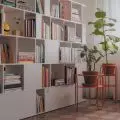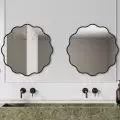Work submitted for the competition
"Best Diploma Architecture"
Funerary architecture has changed over the centuries. This was largely due to the way death was perceived, which had a significant impact on the formation and location of necropolises. Modern trends affecting burial forms are losing the social dimension of death. In response to the current problems, the purpose of the work became to analyze the elements that will allow the restoration of the sacred dimension in funerary objects.
sketches
© Sandra Namyślak
According to many theorists, the cemetery is an image of the living, not the dead. It plays a huge role as a public space connecting the sacred and profane zones. In fact, it is the only place that connects the two zones: life and death, which intertwine and enter into dialogue with each other.
conceptual sketch
© Sandra Namyślak
Today, as a society, we are struggling with the individualization of burial activities and a misunderstanding of the need to undergo proper mourning. As sacred beings, as Mircea Eliade says, we need a bearer of grief and loss, a space that encourages us to face the past and wander through it. The designed building takes the form of a guide, it is like Virgil in Dante's "Divine Comedy". It guides the participant through loss and the emotions that accompany mourning.
site development plan
© Sandra Namyślak
A key element in thinking about the project was the choice of plot. Because of the desire to introduce a symbolic character, it became important to focus on the cemetery as a notion of a "garden for the living". The choice fell on the largest necropolis in Poland — the Central Cemetery in Szczecin. Its form is reminiscent of ancient park and landscape assumptions. The most important element is the historical axis of the establishment, on which the designed object is located.
axonometry
© Sandra Namyślak
Christopher Alexander, in his statements about sacred spaces, mentions the need for a gradation of intimacy until we reach the sacred center. These elements stem from human psychology. An additional element that introduces psychological comfort is the reduction of ceilings, the more intimate the room. This thought became the guiding idea that shaped the body of the building. The "sacred axis", referring to ancient layouts, also stands out in the premise of the entire building.
functions of the building
© Sandra Namyślak
The building's narrative is manifested, among other things, in the sequence of rooms placed directly on the axis. Thanks to the creation of rooms with different scales of intimacy and privacy, everyone has the opportunity to individually experience the path of farewell.
walking patterns
© Sandra Namyślak
Due to the purpose of the building as a sacred place, symbols are present in the building — the main one, which became the key to the design of the building, is light. It acts as a guide to emotions and is a key ornament of the building. The intensity of the light is a reflection of the various emotions that accompany mourning. Starting from pain and suffering, when surrounded by darkness, to regaining hope for a better tomorrow — these emotions are already accompanied by more and more light.
The designed spaces are characterized by minimalism. Their form is based on simple solids, whitewashed walls that shimmer with the chiaroscuro introduced into the interior.
interiors
© Sandra Namyślak
The designed architecture is meant to be a form of "tabula rasa" — the chiaroscuro that forms on the clean, monumental walls is the only changing element during the day. It shows that regardless of events and what happens in our lives, everything around us goes on. The world has not stood still, and we have to keep going, as if we were starting to write further history on new, clean pages.
inner courtyard
© Sandra Namyślak
Sandra NAMYŚLAK
Illustrations: © Author







































































